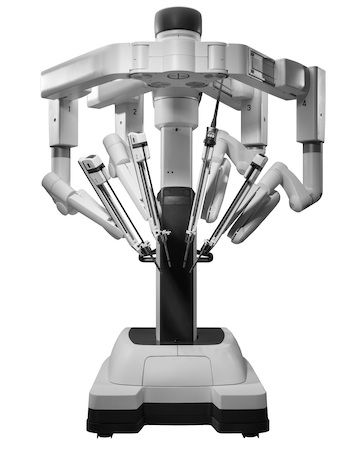Robotic Surgery
 Minimally invasive surgery took a significant step forward with the introduction of robotically assisted bariatric procedures. The da Vinci Surgical System was introduced to combine many of the benefits of open surgery (visualisation and dexterity) with those of laparoscopic surgery (fewer risks and faster recovery). The surgical robot does not perform procedures on its own but is fully controlled by the surgeon sitting near the operating table at a dedicated console.
Minimally invasive surgery took a significant step forward with the introduction of robotically assisted bariatric procedures. The da Vinci Surgical System was introduced to combine many of the benefits of open surgery (visualisation and dexterity) with those of laparoscopic surgery (fewer risks and faster recovery). The surgical robot does not perform procedures on its own but is fully controlled by the surgeon sitting near the operating table at a dedicated console.
Robotic surgical procedures offer several benefits including:
Exceptional dexterity. The wristed robotic arms can rotate 360° within the abdomen, offering surgeons exceptional range of motion that exceeds that of the human wrist. Essentially, robotic surgery allows for the dexterity of an open procedure using only the tiny incisions of traditional laparoscopy.
Greater visualisation. The da Vinci Robotic Surgical System utilises dual camera technology to create a three-dimensional view of the surgical field. The surgeon’s view from the console is magnified and incredibly crisp, allowing for exceptional precision. This is a significant improvement over the two-dimensional view of traditional laparoscopy that, limits depth perception.
Performance of complex procedures laparoscopically. One of the limitations of traditional laparoscopy is the difficulty in performing intricate or complex procedures. Laparoscopic tools are long and have a smaller range of motion. Conversely, the robotic arms are able to access parts of the abdomen that would be out of reach with traditional laparoscopic tools.
Smoothness and Precision. The robot interprets the surgeon’s inputs and scales them down to ensure perfectly smooth movements. This allows for exceptional precision.
Enhanced control. The surgeon controls the robotic arms with both their hands and feet. This allows for the use of three robotic arms while traditional laparoscopy only allows the use of two at a time. Typically, during laparoscopic surgery a surgical assistant is required to operate one or more of the laparoscopic tools.
Surgeon Comfort. During traditional laparoscopy, the surgeon is standing next to the operating table and typically looking up at a television screen. This can be particularly difficult during long surgeries or on days when many surgeries are scheduled. The robot allows the surgeon to sit comfortably at the console, eliminating much of that fatigue.
Is Robotic Surgery Better or Safer Than Laparoscopic Surgery?
In the hands of a skilled and experienced surgeon such as Mr Ahmed, both robotic surgery and laparoscopic surgery is very safe and effective. Both have significant benefits when compared to open surgery, including a shorter hospital stay, shorter recovery as well as a lower risk of incisional hernias, infection, blood loss and pain.
In most cases, laparoscopic surgery offers a similar degree of safety and effectiveness as robotic surgery and as such, either technique can be used very successfully. During consultation with Mr Ahmed, you will learn more about the particulars of your procedure as well as the technique that will be used for surgery.
New Robotic Program
Of note, Mr. Ahmed has launched the new robotic bariatric surgery program at the Bupa Cromwell Hospital and we look forward to providing both robotic and traditional laparoscopic options to appropriate patients.
 Consultant Laparoscopic & Bariatric Surgeon
Consultant Laparoscopic & Bariatric Surgeon





